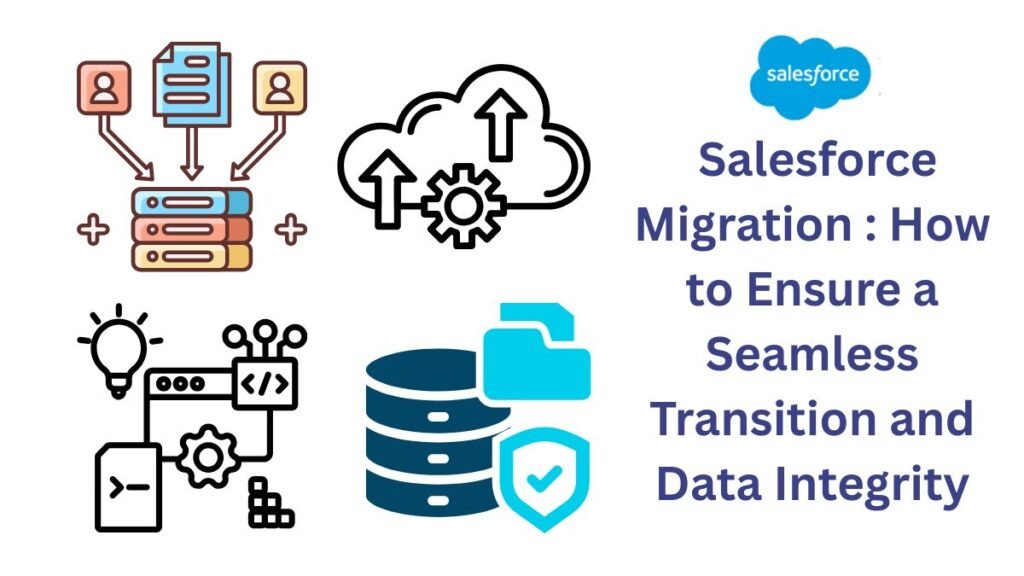Migrating to Salesforce is a significant endeavor that businesses of all sizes undertake to improve their customer relationship management (CRM) systems. Whether transitioning from an on-premises solution, legacy CRM, or even from another cloud-based platform, ensuring a smooth Salesforce migration is critical for a successful transformation. The process can be complex, involving a detailed and well-structured approach that addresses both technical and organizational challenges.
One of the most crucial aspects of a Salesforce migration is maintaining data integrity while ensuring a seamless transition. Data integrity refers to the accuracy, consistency, and reliability of data during its transfer between systems. Any loss, corruption, or inconsistency of data during the migration process can lead to operational disruptions, poor user adoption, and diminished business performance. This article explores key strategies for achieving a seamless Salesforce migration while ensuring data integrity.
1. Detailed Planning and Strategy
A successful Salesforce migration begins with thorough planning. A migration strategy outlines the entire process, setting clear goals, defining success criteria, and identifying potential risks. This phase ensures that all stakeholders are aligned and that the transition is handled efficiently.
Key elements of a migration strategy include:
-
Assessment of Current Systems: Understand the existing CRM and related systems, identifying any integration points, data silos, or custom configurations that need to be carried over to Salesforce.
-
Scope Definition: Define the scope of the migration, detailing what will be moved to Salesforce, including data, customizations, integrations, and user roles.
-
Timeline: Set realistic timelines for each phase of the migration process, ensuring that critical business operations are not disrupted.
-
Resource Allocation: Assign roles and responsibilities to the migration team, ensuring they have the necessary skills and resources to handle the project effectively.
Planning for every eventuality, including backup strategies and testing protocols, helps minimize the risk of complications down the line.
2. Data Mapping and Cleanup
Before migrating data to Salesforce, it is essential to thoroughly understand the structure and quality of the existing data. Data mapping is the process of defining how each data field in the legacy system corresponds to a field in Salesforce. This ensures that no critical data is lost or misaligned during the migration.
Data cleanup is equally important. Migrating dirty or inconsistent data can lead to inaccurate reporting, user errors, and operational inefficiencies. Cleaning up data prior to migration involves:
-
Eliminating Redundancies: Removing duplicate records ensures that only one version of each entry is moved to Salesforce.
-
Validating Data Quality: Ensure that the data being migrated is accurate, consistent, and up-to-date. This might involve fixing missing values, correcting formatting issues, or deleting outdated records.
-
Mapping Custom Fields: Understand any custom fields in the legacy system and determine how they will be handled in Salesforce, ensuring that they are mapped correctly to Salesforce fields or custom objects.
By undertaking a rigorous data cleanup and mapping process, organizations can avoid common pitfalls such as incomplete data, errors in reporting, and misaligned customer records.
3. Pilot Testing
Before fully migrating all data, performing a pilot test is crucial to ensure that everything will work as expected. A pilot test involves migrating a small subset of data, processes, or users to Salesforce in a controlled environment. This allows businesses to identify any potential issues without affecting the entire system.
Pilot testing should focus on:
-
Data Integrity: Ensure that the data is correctly transferred to Salesforce without any discrepancies, ensuring that the data mapping is accurate.
-
Functionality: Test all integrations, workflows, and automation to ensure they function properly with the migrated data.
-
User Experience: Solicit feedback from a small group of users on their experience with the new Salesforce environment, identifying any usability issues.
-
System Performance: Monitor how the Salesforce platform performs with the migrated data, ensuring that it meets the organization’s performance standards.
Once the pilot test is complete, evaluate the results, resolve any issues identified, and refine the migration process before moving forward with the full-scale migration.
4. Migration Execution
The actual migration phase is where the planned strategy and testing come to life. This step involves transferring the data from the legacy system to Salesforce. During migration execution, it is crucial to follow best practices to ensure a seamless transition.
Some key migration execution steps include:
-
Data Migration Tools: Utilize Salesforce’s built-in migration tools, such as the Salesforce Data Import Wizard or Data Loader, to import data efficiently. For more complex migrations, third-party tools can provide additional capabilities for handling large volumes of data.
-
Data Validation: As data is being migrated, validate the accuracy and integrity of each record. Automation tools can assist in this process by running validations to detect errors or inconsistencies.
-
Incremental Migration: If migrating a large dataset, consider performing the migration incrementally, moving data in phases. This reduces the strain on the system and allows for testing after each phase.
-
Data Backup: Always back up the data before migrating. This precaution ensures that in case of an error, the original data is not lost and can be restored.
By carefully managing the execution phase, businesses can avoid common errors like data corruption or loss, ensuring that the migration goes smoothly.
5. Post-Migration Data Validation
After the migration is complete, post-migration validation is critical to ensure that everything has transitioned correctly. This phase involves verifying that the migrated data aligns with the original data and that the system functions as expected.
Key steps in post-migration validation include:
-
Data Reconciliation: Compare the migrated data in Salesforce with the original records in the legacy system to ensure no discrepancies.
-
Spot Testing: Conduct random sampling of data to identify any hidden issues that may not have been detected during the initial validation.
-
User Acceptance Testing (UAT): Have end-users test the Salesforce environment with real data to ensure that it works as expected and meets their needs. This is an important phase to uncover any user-specific issues, such as UI/UX problems or functionality gaps.
Once data validation is complete, businesses can move forward with training users and fine-tuning the system.
6. Training and Adoption
Successful Salesforce adoption goes beyond a seamless migration. Ensuring that users are comfortable with the new system and know how to leverage its features is essential for maximizing the return on investment.
Training programs should be comprehensive, including:
-
System Navigation: Train users on how to navigate the Salesforce interface, manage their data, and use new tools.
-
Workflow Training: Teach users about new workflows, automation, and processes that have been implemented in Salesforce.
-
Ongoing Support: Provide users with resources for ongoing support, such as help desks, user manuals, and a community of Salesforce experts.
Encourage user feedback and make adjustments as necessary to improve the user experience.
7. Continuous Monitoring and Optimization
Once the migration is complete, the work does not stop. Continuous monitoring is essential to identify any issues that may arise post-migration. Regularly check data accuracy, system performance, and user satisfaction.
Optimization can involve refining processes, updating automation rules, or addressing new data integration needs as the business evolves.
Conclusion
Migrating to Salesforce offers businesses an opportunity to modernize their CRM systems and improve overall efficiency. However, the migration process comes with its challenges, particularly concerning data integrity. By planning meticulously, cleaning and mapping data properly, performing pilot tests, executing the migration carefully, and providing continuous support post-migration, organizations can ensure a smooth transition to Salesforce. This approach not only safeguards data integrity but also fosters a positive user experience, ensuring that the benefits of the migration are fully realized.











































